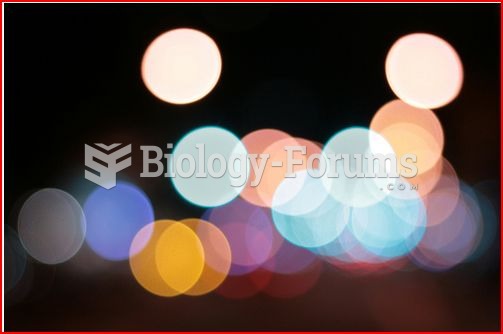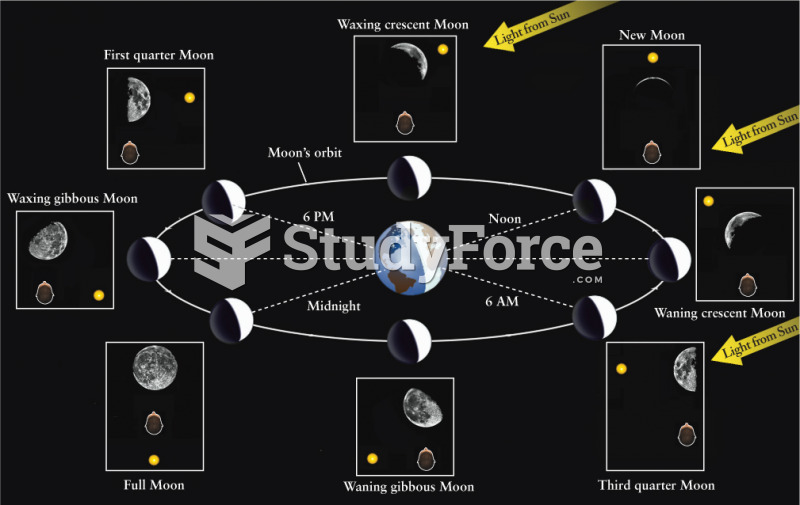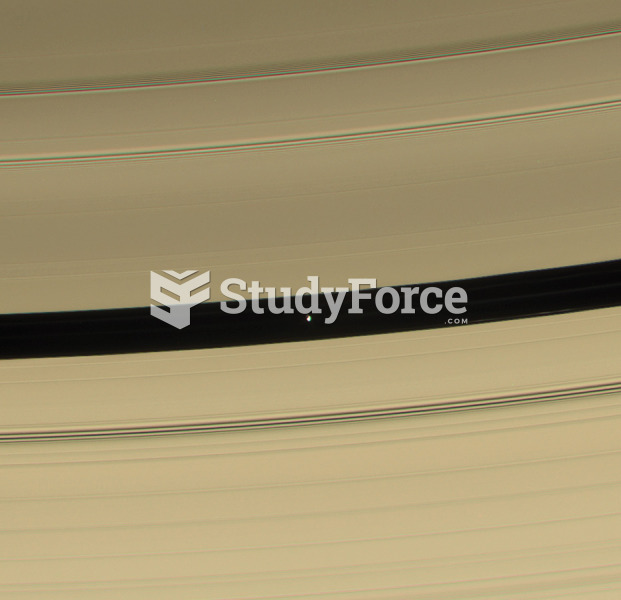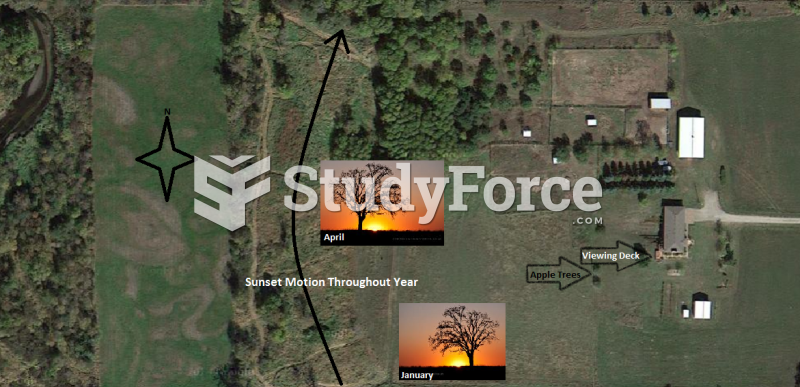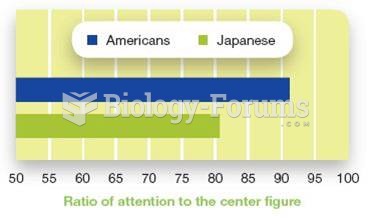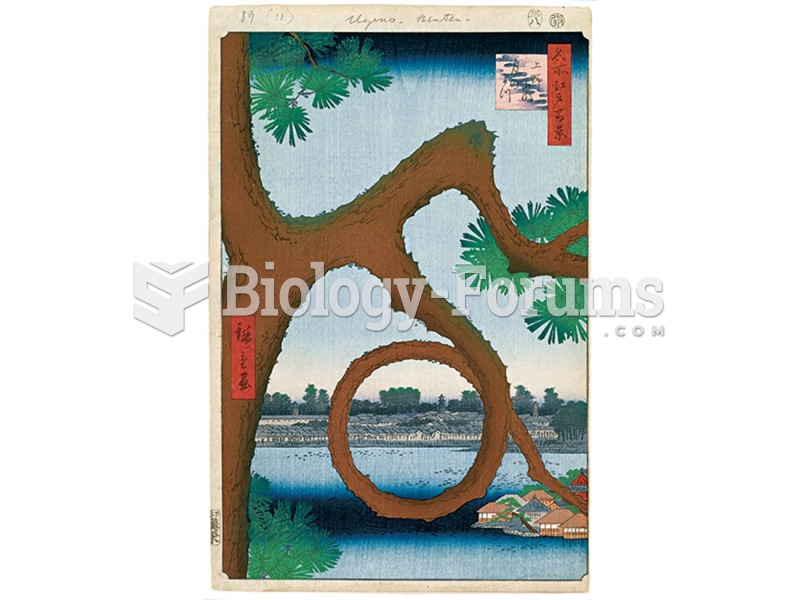When the Moon is 90 west of the Sun, the Moon is in the ______________ phase.
Fill in the blank(s) with correct word
Question 2
A component in an automobile 12-V electrical system has a resistance of 90 . How much current is in the component when in operation?
a. 100 A
b. 0.13 A
c. 7.5 A
d. 1100 A
Question 3
When the adjustable mirror on the Michelson interferometer is moved 20 wavelengths, how many fringe pattern shifts would be counted?
a. 5
b. 10
c. 20
d. 40
e. 80
Question 4
When the Moon appears on an observer's meridian at midnight, it is called a(n) ______________ moon.
Fill in the blank(s) with correct word
Question 5
If work is done on an electric charge, a ______________ is present.
a. resistance
b. current
c. voltage
d. transformer
e. bigger charge
Question 6
When a central dark fringe is observed in reflection in a circular interference pattern, waves reflected from the upper and lower surfaces of the medium must have a phase difference, in radians, of
a. 0.
b. /2.
c. .
d. 3/2.
e. 2.
Question 7
During the 7-3/8 days between the new and first-quarter phases, the Moon is called a(n) ______________ moon.
Fill in the blank(s) with correct word
Question 8
The electrical power dissipated in an appliance depends on
a. voltage.
b. current.
c. resistance.
d. all of these.
Question 9
In an interference pattern, the wavelength and frequency are
a. the same in both the regions of constructive interference and the regions of destructive interference.
b. greater in regions of constructive interference than in regions of destructive interference.
c. smaller in regions of constructive interference than in regions of destructive interference.
d. unchanged in regions of destructive interference but greater in regions of constructive interference.
e. unchanged in regions of destructive interference but smaller in regions of constructive interference.
Question 10
The orbital period of the Moon with respect to a star (other than the Sun) is called a(n) ______________ month.
Fill in the blank(s) with correct word
Question 11
The electrical power dissipated by a resistance R is
a. inversely proportional to I.
b. directly proportional to I2.
c. directly proportional to I.
d. none of these.
Question 12
The bright and dark bands you see in a photograph of a double slit interference pattern represent
a. the respective positions of the crests and the troughs of the light wave.
b. an interference pattern that is not present unless it is produced by the camera lens.
c. the respective positions of constructive and destructive interference of light from the two sources.
d. the respective positions of destructive and constructive interference of light from the two sources.
e. the respective positions of bright and dark particles of light.
Question 13
The Moon revolves eastward around Earth every ______________ solar days.
Fill in the blank(s) with correct word
Question 14
For an ohmic conductor, current is
a. directly proportional to voltage.
b. directly proportional to resistance.
c. independent of resistance.
d. independent of voltage.
Question 15
In a Newton's rings apparatus, find the phase difference (in radians) when an air wedge of 500 nm thickness is illuminated with red light ( = 640 nm).
a. 13
b. 11
c. 9
d. 7
e. 3
Question 16
The oldest Moon rocks are about ______________ years old.
Fill in the blank(s) with correct word
Question 17
For an ohmic conductor, current is
a. inversely proportional to voltage.
b. inversely proportional to resistance.
c. independent of resistance.
d. independent of voltage.
Question 18
A thin sheet of plastic (n = 1.60) is inserted between two panes of glass to reduce infrared ( = 700 nm) losses. What thickness (in nm) is necessary to produce constructive interference in the reflected infrared radiation?
a. 218
b. 109
c. 55
d. 318
e. 443
Question 19
The Moon's average distance from Earth is about ______________ km.
Fill in the blank(s) with correct word
Question 20
Which of the following would be the least conductive?
a. Copper
b. Salt water
c. Glass
d. Mercury
Question 21
The light reflected from a soap bubble (n = 1.40) appears red ( = 640 nm) at its center. What is the minimum thickness (in nm)?
a. 124
b. 104
c. 114
d. 134
e. 234
Question 22
The largest impact features on the surface of the Moon are the ______________ basins.
Fill in the blank(s) with correct word
Question 23
The unit of resistance is called a(n)
a. volt.
b. ampere.
c. coulomb.
d. ohm.
e. watt.
Question 24
Monochromatic light ( = 500 nm) is incident on a soap bubble (n = 1.40). How thick is the bubble (in nm) if destructive interference occurs in the reflected light?
a. 102
b. 179
c. 54
d. 1
e. 89
Question 25
The ______________ on the Moon are believed to have been caused by moonquakes.
Fill in the blank(s) with correct word
Question 26
One ampere one second is a unit of
a. power.
b. current.
c. voltage.
d. electric charge.
e. resistance.
Question 27
Monochromatic light ( = 500 nm) is incident on a soap bubble (n = 1.4) that is 500-nm thick. Calculate the change of phase of the light that penetrates the front surface, reflects from the second surface, and emerges through the first surface as an angle between 0 and 360?
a. 280
b. 160
c. 220
d. 100
e. 290
Question 28
The Moon's maria, or plains, are believed to have been caused by ______________.
Fill in the blank(s) with correct word
Question 29
In a conductor, what moves?
a. Electrons
b. Neutrons
c. Quarks
d. Protons
Question 30
Monochromatic light ( = 500 nm) is incident on a soap bubble (n = 1.4) that is 50 mm thick. What is the change of phase of the light reflected from the front surface?
a. 0
b. 180
c. /2
d. /2
e. 55
Question 31
A large volume of the solar system's space is occupied by
a. meteors.
b. micrometeoroids.
c. asteroids.
d. comets
Question 32
Ohm's law gives the relationship between
a. current and voltage.
b. work and current.
c. current and charge.
d. force and current.
Question 33
Monochromatic light ( = 500 nm) is incident on a soap bubble (n = 1.40). What is the wavelength of the light (in nm) in the bubble film?
a. 255
b. 500
c. 700
d. 357
e. 422
Question 34
A comet consists of
a. a nucleus only.
b. a coma only.
c. a tail only.
d. all of these.
Question 35
The unit for current is the
a. ampere.
b. ohm.
c. coulomb.
d. volt.
Question 36
The electric fields arriving at a point P from three coherent sources are described by E1 = E0 sin t, E2 = E0 sin (t + /4) and E3 = E0 sin (t + /2). Assume the resultant field is represented by Ep = ER sin (t + ). The amplitude of the resultant wave at P is
a. E0.
b. 1.5E0.
c. 1.7E0.
d. 2.4E0.
e. 2.9E0.
Question 37
The tail of a comet is shortest when the comet is
a. closest to the Sun.
b. farthest from the Sun.
c. closest to Earth.
d. farthest from Earth.
Question 38
An object that is positively charged will
a. repel a rubber rod stroked with fur.
b. repel a glass rod stroked with silk.
c. be polarized.
d. none of these
Question 39
In a double slit experiment, the distance between the slits is 0.2 mm and the distance to the screen is 100 cm. What is the phase difference (in degrees) between the waves from the two slits arriving at a point 5 mm from the central maximum when the wavelength is 400 nm? (Convert your result so the angle is between 0 and 360.)
a. 90
b. 180
c. 270
d. 360
e. 160
Question 40
The tail of a comet is longest when the comet is
a. closest to the Sun.
b. farthest from the Sun.
c. closest to Earth.
d. farthest from Earth.
Question 41
An object that is negatively charged will
a. repel a rubber rod stroked with fur.
b. repel a glass rod stroked with silk.
c. be polarized.
d. none of these
Question 42
In a double slit experiment, the distance between the slits is 0.2 mm and the distance to the screen is 150 cm. What is the phase difference (in degrees) between the waves from the two slits arriving at a point P when the angular distance of P is 10 relative to the central peak, and the wavelength is 500 nm? (Convert your result so the angle is between 0 and 360.)
a. 145
b. 155
c. 165
d. 135
e. 95
Question 43
Which of the following is usually burned up in Earth's atmosphere?
a. Asteroid
b. Meteoroid
c. Meteor
d. Meteorite
Question 44
An object that is positively charged will
a. attract a rubber rod stroked with fur.
b. attract a glass rod stroked with silk.
c. be polarized.
d. none of these
Question 45
In a double-slit experiment, the distance between the slits is 0.2 mm, and the distance to the screen is 150 cm. What wavelength (in nm) is needed to have the intensity at a point 1 mm from the central maximum on the screen be 80 of the maximum intensity?
a. 900
b. 700
c. 500
d. 300
e. 600
Question 46
Which of the following is believed to have caused the extinction of the dinosaurs on Earth?
a. An asteroid
b. A meteoroid
c. A comet
d. Interplanetary dust
Question 47
An object that is negatively charged will
a. attract a rubber rod stroked with fur.
b. attract a glass rod stroked with silk.
c. be polarized.
d. none of these
Question 48
Two slits are illuminated with red light ( = 650 nm). The slits are 0.25 mm apart and the distance to the screen is 1.25 m. What fraction of the maximum intensity on the screen is the intensity measured at a distance 3.0 mm from the central maximum?
a. 0.94
b. 0.92
c. 0.96
d. 0.98
e. 0.99
Question 49
Which of the following is(are) believed to be material that never collected into a single planet?
a. Asteroids
b. Meteoroids
c. Comets
d. Interplanetary dust
Question 50
A system of a proton and an electron has a net charge of
a. +1.6 10-19 C.
b. 1.6 10-19 C.
c. 3.2 10-19 C.
d. zero.
Question 51
Two slits are illuminated with green light ( = 540 nm). The slits are 0.05 mm apart and the distance to the screen is 1.5 m. At what distance (in mm) from the central maximum on the screen is the average intensity 50 of the intensity of the central maximum?
a. 1
b. 3
c. 2
d. 4
e. 0.4
Question 52
Which of the following is(are) found mainly between Mars and Jupiter?
a. Asteroids
b. Meteoroids
c. Comets
d. Interplanetary dust
Question 53
A system of a proton and a neutron has a net charge of
a. +1.6 10-19 C.
b. 1.6 10-19 C.
c. 3.2 10-19 C.
d. zero.
Question 54
Two slits separated by 0.050 mm are illuminated with green light ( = 540 nm). How many bands of bright lines are there between the central maximum and the 12-cm position? (The distance between the double slits and the screen is 1.0 m.)
a. 1111
b. 111
c. 11
d. 1
e. 11111
Question 55
The asteroid belt is between the orbits of
a. Earth and Mars.
b. Mars and Jupiter.
c. Earth and Venus.
d. Jupiter and Saturn.
Question 56
A system of an electron and a neutron has a net charge of
a. +1.6 10-19 C.
b. 1.6 10-19 C.
c. 3.2 10-19 C.
d. zero.
Question 57
Two slits separated by 0.10 mm are illuminated with green light ( = 540 nm). Calculate the distance (in cm) from the central bright-region to the fifth bright band if the screen is 1.0 m away.
a. 2.3
b. 2.5
c. 2.7
d. 2.1
e. 2.0
Question 58
Which planet has a large moon with retrograde motion?
a. Jupiter
b. Saturn
c. Uranus
d. Neptune
Question 59
A system of 18 electrons and 11 neutrons has a net charge of
a. 28.8 10-19 C.
b. 28.8 10-19 C.
c. 11.2 10-19 C.
d. 18.0 10-19 C.
e. 11.2 10-19 C.
Question 60
For small angle approximations
a. the angle must be 10 or less
b. the angle must be 10 radians or less
c. the angle must be 1 or less
d. the angle must be 1 radian or less
e. the angle must be 45 or less
Question 61
Which of the following moons has retrograde motion?
a. Ganymede
b. Titan
c. Miranda
d. Triton
Question 62
A system of 11 protons and 15 neutrons has a net charge of
a. 17.6 10-19 C.
b. 17.6 10-19 C.
c. 41.6 10-19 C.
d. 11.0 10-19 C.
e. 41.6 10-19 C.
Question 63
Light is incident on a double-slit. The fourth bright band has an angular distance of 7.0 from the central maximum. What is the distance between the slits (in m)? (Assume the frequency of the light is 5.4 1014 Hz.)
a. 27
b. 21
c. 24
d. 18
e. 14
Question 64
Which planet's major moons were named after literary characters?
a. Jupiter
b. Saturn
c. Uranus
d. Neptune
Question 65
A system of 12 electrons and 18 protons has a net charge of
a. 9.6 10-19 C.
b. 9.6 10-19 C.
c. 17.6 10-19 C.
d. 6.0 10-19 C.
e. 17.6 10-19 C.
Question 66
Estimate the distance (in cm) between the central bright region and the third dark fringe on a screen 5.00 m from two double slits 0.500 mm apart illuminated by 500-nm light.
a. 3.47
b. 2.15
c. 1.75
d. 1.50
e. 1.25
Question 67
Which planet has the second largest moon in the solar system?
a. Jupiter
b. Saturn
c. Uranus
d. Neptune
Question 68
A system of 8 electrons, 18 protons, and 4 neutrons has a net charge of
a. 16.0 10-19 C.
b. 16.0 10-19 C.
c. 22.4 10-19 C.
d. 10.0 10-19 C.
e. 22.4 10-19 C.
Question 69
A laser beam ( = 694 nm) is incident on two slits 0.100 mm apart. Approximately how far apart (in m) will the bright interference fringes be on the screen 5.00 m from the double slits?
a. 3.47 103
b. 3.47 102
c. 3.47 104
d. 3.47 106
e. 3.47 105
Question 70
Which of Jupiter's moons is believed to be covered with water ice and possibly have life sustaining conditions?
a. Io
b. Europa
c. Ganymede
d. Callisto
Question 71
A system of an electron, a proton, and a neutron has a net charge of
a. +1.6 10-19 C.
b. 1.6 10-19 C.
c. 3.2 10-19 C.
d. zero.
Question 72
Suppose a 5.0-meter diameter telescope were constructed on the dark side of the moon. The viewing there (except for brief periods of sunlight) would be excellent. As an example, what would be the separation between two objects that could just be resolved on the planet Mars in 500 nm light? The distance to Mars at closest approach is 50 million miles.


